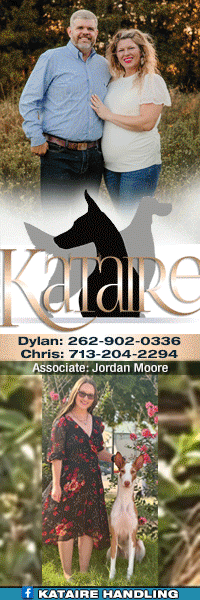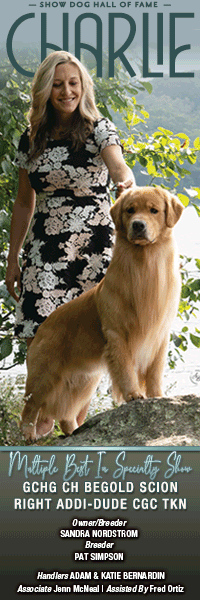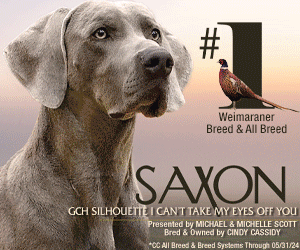An Eye for a Dog
Click here to read the complete article
From the archives of The Canine Chronicle, June, 2015
By Dr. Gerry G. Meisels
 “She sure has an eye for a dog” is a compliment and an expression of respect. This honor and accolade is reserved for those few people who seem to be able to identify unerringly the highest quality dogs coming closest to the standard in many and even most breeds. Is this eye for a dog a natural gift, is it developed over time, and can anyone acquire it with enough time and effort? Having an eye for a dog requires two main characteristics: knowledge of type and structure, and objective judgment without distraction by extraneous factors. How are these characteristics acquired? They certainly are not inherited but are developed through study and observation, and also require personal traits that no training program can develop.
“She sure has an eye for a dog” is a compliment and an expression of respect. This honor and accolade is reserved for those few people who seem to be able to identify unerringly the highest quality dogs coming closest to the standard in many and even most breeds. Is this eye for a dog a natural gift, is it developed over time, and can anyone acquire it with enough time and effort? Having an eye for a dog requires two main characteristics: knowledge of type and structure, and objective judgment without distraction by extraneous factors. How are these characteristics acquired? They certainly are not inherited but are developed through study and observation, and also require personal traits that no training program can develop.
The questions posed above can be answered largely by following how the involvement in the sport develops for most people. On one extreme, there are those few people who are born into “dog families”, families that are heavily engaged in the sport as experienced and knowledgeable exhibitors, professional handlers, and/or breeders. On the other extreme are people who came into the sport and maybe even into dog ownership as grown-ups. Both paths can lead to an eye for a dog, but the different starting points require different approaches to developing an “EFAD” –?eye for a dog.
Young people coming from “doggie” families have many advantages because they are familiar with many aspects of the sport and the world of purebred dogs and conformation dog shows. They also are at risk of being preoccupied with whatever specific conformation aspect is a priority for the family, and of having become jaded by the inevitable frustrations, disappointments, and only too often the perception that dog shows are about the handler more than about the dog. I have stood by ringside many times hearing about how this win was set up or that person had an unfair “political” advantage, said in full earshot of a young observer or junior handler. What these young people need to develop more than anything else is objectivity and judgment.
The growth of a mature entrant to acquiring an EFAD can be tracked by following their growth in the sport. Most serious new entrants begin with a dog they love and of which they are proud. They want to validate their belief that theirs is really a great dog. If they are really serious, they will try to learn all about the breed as well, progressing from believing in their dog to knowing their breed. They will also attend enough shows with quality competition to train their eyes to recognize quality in any dog of their breed, and evaluate their dog in comparison to others. Pretty soon, if their dog is really good, they will win breeds and compete in their group. Now to understand what happens at that level of competition, they must get to know other breeds as well, expanding their horizon and training their eyes. They also learn about their own breed in the process. I vividly remember sitting through a number of breeders’ seminars about my own breed many years ago, in which a particular part of the skeletal structure was described as unique. I did not learn until I studied other breeds’ standards that this statement was poppycock, that there were at least three other breeds with the same skeletal characteristic! What they have just done then is progress from knowing their breed to knowing all or most of the breeds in their group.
What do you do when your group is the last to be judged? If you are serious about learning about dogs, you will stay ringside and watch other groups. If you do this regularly at enough shows, and you make the investment in learning not just from books and standards but by seeing good and even great dogs in the ring, you gradually progress from knowing dogs in your group to knowing all or at least most breeds. Nothing trains for EFAD better than seeing great examples of many breeds. Are all breed winners great dogs? Of course not. Are all group placing dogs great dogs? Of course not. But by far the overwhelming number of top winning dogs are very, very good dogs. Seeing them trains your eye much better than memorizing standards. But these dogs must be seen – and going to your local show even a dozen times a year is not good enough to see many great dogs. I know many breeders and exhibitors who have not made that investment, who have not sought to learn, who have not had the humility to admit that they must learn, and who have not developed that EFAD even for their own breeds after decades of showing and breeding.
Even following this long-term, relatively intense process of training the eye is not enough. An EFAD also requires personal characteristics no matter which path to the goal is taken: personal integrity, objectivity, and judgment. If they are lacking, opinions of dogs will vary as the weather vane in the wind. The wind may be people, faces, and other factors that should have no place in evaluating dogs. Judges especially must guard against the wind of potential future assignments and personal friendships. The search for acquiring EFAD is never-ending even for those closest to having this talent. The investment in learning, participating, and rejecting false influences is ongoing for anyone who wants to acquire or sustain their EFAD.
Many barriers must be surmounted to develop an EFAD. An EFAD is certainly not something with which anyone is born. Only few acquire it. Those who have an eye for a dog because they possess the necessary personal characteristics and have invested extensively in learning are deserving of our special respect.
I gratefully acknowledge numerous helpful and insightful discussions with my wife Sylvia.
Short URL: http://caninechronicle.com/?p=79806
Comments are closed












